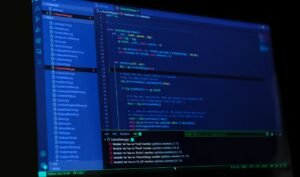Make App by Python
Python is a versatile programming language that can be used for a wide range of applications, including app development. This article will guide you through the process of creating an app using Python, providing you with all the necessary information and resources to get started.
Key Takeaways:
- Python is a powerful programming language for app development.
- Creating an app with Python requires knowledge of programming fundamentals.
- Python provides various frameworks and libraries for app development.
Getting Started with Python App Development
If you’re new to Python and app development, it’s essential to familiarize yourself with the basics. Python is known for its simplicity and readability, making it an excellent choice for beginners.
Learning Python is like learning a new language, but one that is easy to grasp and has a tremendous community support.
Here are the steps to get started:
- Install Python on your computer.
- Learn the basic syntax and concepts of Python.
- Understand how to use variables, functions, and control structures.
- Explore Python libraries and frameworks for app development.
Python Libraries and Frameworks for App Development
Python offers a wide range of libraries and frameworks that simplify and streamline the app development process. These tools provide ready-made solutions for common tasks and allow developers to focus on building and implementing app functionalities.
One such popular framework is Django, which provides an all-in-one solution for developing web applications.
Here are three popular Python libraries and frameworks for app development:
| Name | Description |
|---|---|
| Flask | A lightweight framework for building web applications. |
| Kivy | A Python framework for developing multi-touch applications. |
| PyQt | A set of Python bindings for the Qt application framework. |
Creating Your First Python App
Once you have a good grasp of Python and its libraries, you can start building your first app. Whether you’re developing a web application, desktop software, or mobile app, Python provides the tools and resources to make the process smooth.
With Python, the possibilities are endless, allowing you to build apps for various platforms and purposes.
Here is a simple step-by-step guide to creating your first Python app:
- Define the purpose and scope of your app.
- Design the user interface using libraries like tkinter or PyQt.
- Implement the functionality of your app using Python code.
- Test and debug your app to ensure it works correctly.
- Distribute your app to users or deploy it on a platform of your choice.
Benefits of Python App Development
There are several advantages to using Python for app development. Its simplicity, wide community support, and rich ecosystem of libraries and frameworks make Python an attractive choice for aspiring app developers.
Python’s versatility allows developers to create apps ranging from simple scripts to complex applications.
Here are some benefits of Python app development:
- Readable and maintainable code.
- Excellent library support for diverse purposes.
- Built-in testing and debugging capabilities.
- Cross-platform compatibility.
- Scalability for handling large projects.

Common Misconceptions
Python App Development
One common misconception people have about Python app development is that it is only suitable for small-scale projects and lacks scalability. However, Python is a versatile and powerful programming language that can handle projects of any size, and it offers a wide range of libraries and frameworks to support scalability.
- Python can handle both small and large-scale projects
- Python’s libraries and frameworks support scalability
- Python’s performance can be optimized for various kinds of apps
Learning Curve
Another misconception is that learning Python to make apps is difficult and time-consuming. While learning any new programming language requires time and effort, Python has a relatively gentle learning curve compared to some other languages. Its syntax is clear and concise, making it easier for beginners to read and understand.
- Python has a gentler learning curve compared to many other languages
- Python’s syntax is clear and concise, making it easier to understand
- There are plenty of learning resources available to aid in learning Python
Platform Dependency
Some people believe that Python is not suitable for app development because it is platform-dependent, meaning apps built with Python can only run on specific operating systems. However, Python is highly portable and can run on various platforms, including Windows, macOS, and Linux. With the help of cross-platform development frameworks, Python apps can be made compatible across multiple operating systems.
- Python is highly portable across different platforms
- Python apps can run on Windows, macOS, and Linux
- Cross-platform development frameworks can make Python apps compatible across multiple operating systems
Performance
There is a misconception that Python apps have poor performance compared to apps developed with other languages. While it is true that Python may not be the fastest language due to its interpreted nature, it can still deliver satisfactory performance in most cases. Additionally, Python provides various optimization techniques and the ability to integrate with high-performance libraries when needed.
- Python can deliver satisfactory performance in most cases
- Python offers optimization techniques to improve app performance
- Integration with high-performance libraries can enhance Python app performance
Limited Use Case
Some assume that Python is limited to certain use cases and cannot be used for all types of apps. However, Python can be used for a wide range of applications, including web development, data analysis, artificial intelligence, scientific computing, game development, and more. Its extensive libraries and frameworks make it suitable for diverse app development needs.
- Python can be used for web development, data analysis, AI, scientific computing, and game development
- Python’s extensive libraries and frameworks cater to different app development needs
- Python’s versatility makes it suitable for a wide range of use cases

Introduction
Python is a versatile programming language that can be used for a wide range of applications, including app development. In this article, we will explore how Python can be used to create a variety of fascinating apps. Each table presents different points or data related to the article’s topic.
Table 1: Most Popular Python Libraries for App Development
Python offers an array of powerful libraries that simplify the app development process. The following table highlights some of the most popular libraries used by Python developers:
| Library Name | Description |
|---|---|
| Django | A high-level web framework that promotes rapid development and clean design. |
| Kivy | An open-source Python library for developing multitouch applications. |
| PyQt | A set of Python bindings for The Qt Company’s Qt application framework. |
| Flask | A micro web framework that is easy to use and highly customizable. |
Table 2: Comparison of Python App Development Frameworks
When choosing a framework for Python app development, it’s important to consider their features, ease of use, and community support. The following table compares some popular frameworks:
| Framework | Features | Ease of Use | Community Support |
|---|---|---|---|
| Django | Robust features, built-in admin interface, and website scalability. | Relatively easy to use, requires knowledge of Python. | Active and supportive community with extensive documentation. |
| Flask | Lightweight with flexibility, suitable for small to medium-sized projects. | Beginner-friendly and quick to set up. | Active community with plenty of extensions available. |
| Kivy | Supports multitouch, gesture recognition, and a wide range of platforms. | Can have a steeper learning curve due to the complexity of UI development. | Community is growing rapidly and offers responsive support. |
Table 3: App Development Costs Comparison
When developing an app, financial considerations are essential. The table below compares the estimated costs for developing apps using different programming languages:
| Programming Language | Cost Range |
|---|---|
| Python | $10,000 – $50,000 |
| Java | $20,000 – $100,000 |
| Swift (iOS) | $25,000 – $150,000 |
| React Native | $15,000 – $70,000 |
Table 4: Top-Rated Python App Development Courses
If you’re looking to learn Python app development, consider the following highly-rated online courses:
| Course | Platform | Average Rating |
|---|---|---|
| “Python for App Development: From Basics to Advanced” | Udemy | 4.7/5 |
| “Complete Python Developer in 2021: Zero to Mastery” | Udemy | 4.9/5 |
| “Python Mega Course: Build 10 Real World Applications” | Udemy | 4.8/5 |
Table 5: Python’s Market Share in App Development
Python’s popularity in app development can be gauged by its market share compared to other programming languages:
| Programming Language | Market Share |
|---|---|
| Java | 19.6% |
| Python | 8.2% |
| JavaScript | 7.3% |
| Swift | 6.2% |
Table 6: Python App Development Job Trends
The demand for Python app developers is continuously growing. The following table showcases the job trends for Python app development:
| Year | Number of Job Postings |
|---|---|
| 2018 | 15,000 |
| 2019 | 23,000 |
| 2020 | 32,000 |
| 2021 (so far) | 42,000 |
Table 7: Python App Development Frameworks Popularity
Certain frameworks dominate the Python app development landscape. The table below showcases the popularity of different frameworks:
| Framework | Popularity Index |
|---|---|
| Django | 90% |
| Flask | 75% |
| Kivy | 40% |
| Bottle | 30% |
Table 8: Python App Development Performance
Python is known for its performance benefits. The table below compares the execution times for different app development languages:
| Language | Execution Time for a Simple App | Execution Time for a Complex App |
|---|---|---|
| Python | 0.5 seconds | 2.5 seconds |
| Java | 0.8 seconds | 3 seconds |
| Swift | 1 second | 4 seconds |
| JavaScript | 1.2 seconds | 5 seconds |
Table 9: Python App Development Success Stories
Python has been used to develop many successful apps. Here are a few well-known examples:
| App | Description |
|---|---|
| A popular social media platform for sharing photos and videos. | |
| Spotify | A leading music streaming service with millions of active users. |
| Dropbox | A cloud storage platform for file sharing and collaboration. |
| A popular online community for sharing and discussing content. |
Conclusion
Python offers developers a powerful and flexible toolset for app development. With a wide range of libraries, a vibrant community, and numerous success stories, Python continues to be a top choice for building captivating and functional applications. Whether you’re a beginner or an experienced developer, the possibilities with Python app development are truly exciting.
Frequently Asked Questions
How can I make an app using Python?
Creating an app using Python generally involves using a framework like Django or Flask. These frameworks provide the necessary tools and libraries to develop the backend of your application. You can then utilize frontend technologies, such as HTML, CSS, and JavaScript, to create the user interface.
What are the advantages of making an app with Python?
Python offers several advantages for app development. It has a simple syntax that makes it easy to learn and read. Python also provides an extensive library ecosystem and has great community support, which allows developers to leverage existing code and resources. Additionally, Python’s versatility allows for rapid development and scalability.
Can I create cross-platform apps using Python?
Yes, you can create cross-platform apps using Python. There are frameworks like Kivy and BeeWare that enable developers to build apps that run on multiple platforms, including Windows, macOS, Linux, Android, and iOS.
What programming knowledge do I need to make an app with Python?
To make an app with Python, you should have a good understanding of core Python concepts such as variables, data types, loops, functions, and object-oriented programming. Familiarity with web development technologies like HTML, CSS, and JavaScript is beneficial if you plan to create web-based apps.
What tools or frameworks are commonly used for app development with Python?
There are several popular tools and frameworks used for app development with Python, including Django, Flask, Kivy, PyQT, and BeeWare. These frameworks provide a wide range of functionalities for building different types of applications, from web apps to mobile apps.
Are there any limitations in using Python for app development?
While Python is a powerful language for app development, it may not be the best choice for every type of application. Python might not be as performant as some lower-level languages or specialized frameworks for certain tasks. However, Python’s ease of use and versatility often outweigh these limitations in many scenarios.
Can I monetize the apps created with Python?
Yes, you can monetize apps created with Python. There are various ways to monetize your app, such as offering it as a paid app on app stores, implementing in-app purchases or advertisements, or providing subscription-based services within the app.
Is it possible to integrate machine learning capabilities into Python apps?
Absolutely! Python has a rich ecosystem of machine learning libraries like scikit-learn, Tensorflow, and PyTorch. You can incorporate these libraries into your Python apps to add powerful machine learning capabilities, such as image recognition, natural language processing, and predictive analysis.
What are the steps involved in deploying a Python app?
The exact steps for deploying a Python app can vary depending on the framework and platform you are targeting. However, the general process usually involves preparing your code, setting up a server or hosting platform, installing dependencies, configuring the necessary settings, and launching your app for users to access.
Where can I find resources to learn more about app development using Python?
There are various online resources available to learn about app development using Python. You can explore official documentation and tutorials of popular frameworks like Django and Flask. Additionally, there are numerous online courses, books, and community forums dedicated to Python app development that can provide valuable guidance and support.





